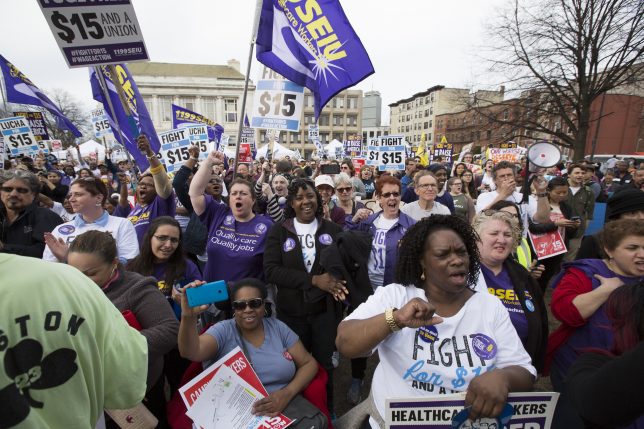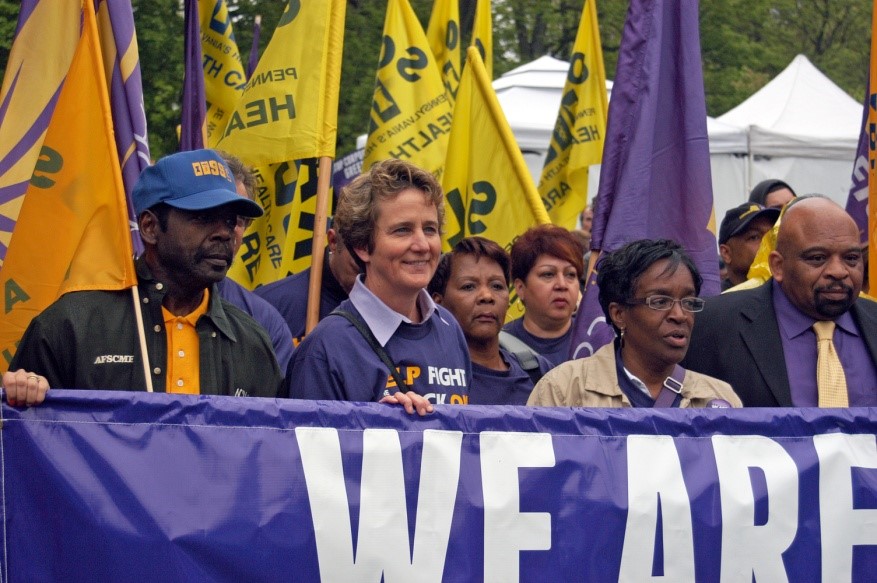Labor Watch
Inside the SEIU: Campaigning on Intimidation
Part Two in a Labor Watch series on the Service Employees International Union
 Image via NH Labor News, goo.gl/9W2uye
Image via NH Labor News, goo.gl/9W2uye

Read Part One here.
Summary: The Service Employees International Union is a mainstay of the professional Left and Big Labor. In Part Two of “Inside the SEIU,” we take a closer look at the union’s ties to the professional Left, and how it strong-arms big companies into unionizing workers under the SEIU aegis.
Enter Mary Kay Henry
Andy Stern, the longtime SEIU chief responsible for growing the union into a major left-wing power broker, abruptly resigned from SEIU’s presidency in April 2010. He was succeeded by Mary Kay Henry, the union’s executive vice president, in what was considered an underdog victory. A longtime union hack, Henry joined the SEIU as an organizer after graduating from Michigan State University in 1980. She rose through the ranks to organizing director and chief healthcare strategist in 1996 before reaching the highest rungs of leadership in 2004.
Henry’s left-wing credentials are unsurprisingly immaculate: She has served on the boards of the Democracy Alliance, a far-left donors’ group and leftist clearinghouse Politico calls “the left’s secret club”—the Economic Policy Institute, American Income Life, and Fresh Thinking, and is an advisory member of the National Catholic Scholars for Worker Justice. She is also secretary-treasurer of Change to Win.
Henry continued her predecessor’s aggressive involvement in establishment Democratic Party politics, to the annoyance of more ideologically motivated leftists in the union. Henry secured the SEIU Presidential endorsement for former Secretary of State Hillary Clinton in November 2015, before the 2016 Democratic primary had begun in earnest. Many union activists thought the SEIU should have endorsed self-described socialist Senator Bernie Sanders (I-Vermont) for his support for the SEIU’s Fight for $15 campaign. Clinton did not fully support the measure.
Under Henry the SEIU’s political and lobbying program spending reached $60 million, or 20 percent of its $314.6 million annual budget to no avail. Its campaigns have flopped. Besides substantial electoral losses in the 2016 elections, the SEIU has reportedly spent another $19 million on its campaign to raise minimum wages to $15 per hour. This campaign has had little success outside of major left-wing stronghold cities such as Seattle, Washington; Chicago, Illinois; and Washington, D.C. Despite picking up 15,000 new members last year, the SEIU has actually lost revenue. The union was forced to cut its budget by some 30 percent and lay off staff in its Washington, D.C. headquarters.
Mega-Locals
The SEIU is built around a national core and large “mega-locals” that organize entire industries within and sometimes across states. These mega-locals represent both private sector and public-sector workers. Owing to Department of Labor rules, SEIU mega-locals which exclusively represent state employees are not required to file periodic reports. A few of these public sector mega-locals are enormous, none more so than SEIU Local 1000, which claims 95,000 members in California. Private sector locals are even larger: Three reported over 100,000 members to the Department of Labor in 2015. Another eight reported over 40,000 members.
1199SEIU, United Health Care Workers East, one of the most powerful labor unions in New York, is a principal player in the state’s progressive movement. According to Department of Labor filings, the union reported 351,149 members and spent $186 million in fiscal year 2015, of which $41 million was per capita tax paid to national and regional SEIU bodies.
SEIU Local 2005, United Health Care Workers West is another powerful mega-local based in California. Formed during Andy Stern’s tenure, Local 2005 recently lost a large portion of its membership to another California SEIU mega-local, Local 2015, in a national headquarters-directed restructuring. But Local 2015’s creation proved controversial within the union, with Henry’s internal rivals suggesting that the reorganization and greater autonomy only served to secure Henry’s position as union president. Local 2005 president Dave Regan denounced the top-down governance strategy—ironically, the very system which got him elected in the first place.
This mega-local structure has understandably led to criticism. Because locals are highly consolidated, national leadership can maintain firm control over internal politics and elections. This has led to calls for reorganization under what proponents put forward as “union democracy.” In 2008, the ex-leadership of United Health Care Workers West resigned en masse in protest and left the SEIU altogether, forming the independent National Union of Healthcare Workers.

Mary Kay Henry, president of the SEIU
Political Activity
The SEIU pioneered the “corporate campaign” or “comprehensive campaign,” an aggressive form of union organizing aimed at bypassing secret ballot votes. This tactic targets consumers and others in an effort to damage a chosen corporation’s brand; thus, it becomes more expensive to fight SEIU’s attacks than to give in and allow them to gain exclusive representation of all employees. This racket’s ultimate goal is to unionize workers without uncomfortable secret-ballot votes, which unions often lose despite substantial institutional advantages in the voting process. In a secret ballot, after all, an individual can vote his conscience without fear of reprisal.
In the 2010 edition of its self-published history, Stronger Together: The Story of SEIU, the union spins its organizing strategy with euphemisms and special phrasing. As Jeremy Milloy, a reviewer at Simon Fraser University, put it, “Workers do not ‘join’ the union or ‘organize;’ they ‘unite with’ the union.” He adds:
This rhetorical device allows SEIU to dodge some of the tricky questions about how the union’s growth has been achieved. In many cases, adding new workers is a top-down process that is not driven by the concerns and priorities of the workers themselves, but by a top-level negotiation between SEIU management and large employers. These negotiations produce agreements that transcend neutrality agreements by allowing companies to decide which workplaces can be organized by the union, and which workers will not have the opportunity to “unite” with SEIU.
The Sodexo Campaign
One of the SEIU’s most notorious corporate campaigns attacked Sodexo, a food service vendor. The campaign was so sleazy that Sodexo sued the union under the Racketeer Influenced and Corrupt Organizations Act (RICO), a law devised to combat organized crime syndicates. The suit followed what Sodexo called “extortionate threats and [a] barrage of unlawful tactics,” alleging the SEIU had committed “blackmail, vandalism, trespass, harassment, and lobbying violations.”
As part of the litigation surrounding the “Clean Up Sodexo” campaign, the SEIU disclosed its “Contract Campaign Manual,” the book of organizing principles and intimidation tactics behind the comprehensive campaign model. Vincent Vernuccio of the Mackinac Institute described the SEIU playbook:
SEIU’s manual details how “outside pressure can involve jeopardizing relationships between the employer and lenders, investors, stockholders, customers, clients, patients, tenants, politicians, or others on whom the employer depends for funds.” The union advises using legal and regulatory pressure to “threaten the employer with costly action by government agencies or the courts.”
It details the use of community groups to “damage an employer’s public image and ties with community leaders and organizations.” SEIU recommends going after company officials personally. Not mincing words, SEIU states, “It may be a violation of blackmail and extortion laws to threaten management officials with release of ‘dirt’ about them if they don’t settle a contract. But there is no law against union members who are angry at their employer deciding to uncover and publicize factual information about individual managers.”
The SEIU ultimately settled with Sodexo and ended their campaign of intimidation.
Part III of “Inside the SEIU” delves into the Fight for a $15 minimum wage and its Medicaid dues-skimming scheme.
Read Part One here.
Watch CRC’s short video on the Service Employees International Union here:

